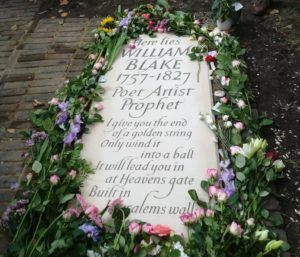Earlier this month, a new gravestone was unveiled in Bunhill Fields. Here is one of those little and hidden patches of London, set between Old Street and the City, where the dead lie as sentinels guarding quiet open space against the encroachments of glass towers, technological progress and furious money-making.

Originally a place reserved for the burial of dissenters, it is a perfect resting place for William Blake: poet, visionary and professional Londoner. Gathered around his grave were a curious gathering of bearded clerics and heavy metal rock stars. And with a new exhibition of his paintings set to open at Tate Britain next week, we are invited to “rediscover him as a visual artist for the 21stcentury”.
And not before time. Like the prophets of the Bible that so inspired him, Blake writes and paints so far outside of the Overton window that many think him touched by madness. That, of course, is precisely the prophetic vocation. When Blake was eight, he saw a vision of angels in a tree on Peckham Common. His father nearly beat him for maintaining so ridiculous a thing. But it was Blake’s feverish theological imagination that enabled him to recognise the failure of the established church to describe a God of mercy and forgiveness, and the implication of the whole establishment in the de-humanising “dark satanic mills” of the industrial revolution – his phrase for what we might now call the ‘military-industrial complex’.
Blake’s radicalism was to suggest that the God that was worshiped in established churches bore a remarkable resemblance to Satan himself – God as the stern rule giver, God as the condemnation of humanity. For Blake, true Christianity was the enemy of creeds and rules and ecclesiastical pomp. Rather, Christianity was a way of seeing the world, an act of imagination in which Jesus is more like some spiritual inner light which illuminates the world.
It always disappointed me that my old friend Colin Slee (RIP), the former Dean of Southwark cathedral, banned the singing of the hymn Jerusalem in Blake’s local cathedral. He thought it nationalistic nonsense.
“And did those feet in ancient time, walk upon England’s mountains green?”
Well, obviously not. But this literalism misses the point. No, Jesus didn’t go on some first century gap year to Glastonbury, as the Arthurian legends have it. But as a Vicar in one of the parishes where Blake would regularly wander around, looking at angels, I can attest to the fact that Jesus does, even now, pad about in South London. I saw him recently in the faces of the children who made wonderful cardboard trees to decorate the sanctuary for our Summer Art project.
This may sound overly esoteric to many – welcome to Blake – but with these cardboard trees and using blue kneelers as a makeshift river, we set up in my church a tableau of Ezekiel’s vision of water flowing from the Temple, feeding all life (Ezekiel 47). Blake loved Ezekiel. He said that he saw the prophet under his bed when he was four years old. If this is madness, it is my kind of madness. And it issued in some of Albion’s most fascinating works of art. Check them out at the Tate Britain. The exhibition opens on the 11thSeptember.








Join the discussion
Join like minded readers that support our journalism by becoming a paid subscriber
To join the discussion in the comments, become a paid subscriber.
Join like minded readers that support our journalism, read unlimited articles and enjoy other subscriber-only benefits.
Subscribe